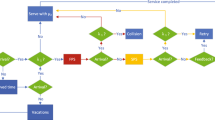Abstract
The optimal scheduling problem in two queueing models arising in multihop radio networks with scheduled link activation is investigated. A tandem radio network is considered. Each node receives exogenous arriving packets which are stored in its unlimited capacity buffer. Links adjacent to the same node cannot transmit simultaneously because of radio interference constraints. The problem of link activation scheduling for minimum delay is studied for two different traffic types. In the first type all packets have a common destination that is one end-node of the tandem. In this case the system is modeled by a tandem queueing network with dependent servers. The server scheduling policy that minimizes the delay is obtained. In the second type of traffic, the destination of each packet is an immediate neighbor of the node at which the packet enters the network. In this case the system corresponds to a set of parallel queues with dependent servers. It is shown that the optimal policy activates the servers so that the maximum number of packets are served at each slot.
Similar content being viewed by others
References
E. Arikan, Some complexity results about packet radio networks, IEEE Trans. Inf. Theory IT-30 (1984) 681–685.
I. Chlamtac and A. Lerner, Fair algorithm for maximal link activation in multihop packet radio networks, IEEE Trans. Commun. COM-35 (1987) 739–746.
I. Cidon and M. Sidi, Distributed assigned algorithms for multi-hop packet-radio networks, IEEE Trans. Comput. C-38 (1989).
A. Ephremides and T. Truong, A distributed algorithm for efficient and interference-free broadcasting in radio networks, IEEE Trans. Commun. COM-38 (1990).
B. Hajek and G. Sasaki, Link scheduling in polynomial time, IEEE Trans. Inf. Theory IT-34 (1989) 910–917.
L. Kleinrock and J.A. Silvester, Spatial reuse in multihop packet radio networks, Proc. IEEE 75 (1987).
R. Nelson and L. Kleinrock, Spatial TDMA: A collision-free multihop channel access protocol, IEEE Trans. Commun. COM-33 (1985) 934–944.
M.J. Post, P.E. Sarachic and A.S. Kershenbaum, A biased-greedy algorithm for scheduling multi-hop radio networks, in:Proc. 19th Annu. Conf. on Information Sciences and Systems (March 1985) pp. 564–572.
Z. Rosberg and M. Sidi, TDM policies in multistation packet radio networks, IEEE Trans. Commun. COM-37 (1989).
J.A. Silvester, Perfect scheduling in multi-hop broadcast networks,Proc. ICCC, London (September 1982).
D. Stoyan,Comparison Methods for Queues and Other Stochastic Models (Wiley, 1983).
L. Tassiulas, Dynamic link activation scheduling in multihop radio networks with fixed or changing connectivity, Ph.D. Dissertation, University of Maryland, College Park (1991).
L. Tassiulas and A. Ephremides, On the activation of servers in queueing systems that model radio networks, in:Proc. 28th CDC, Tampa, FL (1989).
L. Tassiulas and A. Ephremides, Stability properties of constrained queueing systems and scheduling for maximum throughput in multihop radio networks, IEEE Trans. Auto. Control AC-38 (1992).
J. Walrand,Queueing Networks (Prentice-Hall, 1988).
Author information
Authors and Affiliations
Rights and permissions
About this article
Cite this article
Tassiulas, L., Ephremides, A. Dynamic scheduling for minimum delay in tandem and parallel constrained queueing models. Ann Oper Res 48, 333–355 (1994). https://doi.org/10.1007/BF02024520
Issue Date:
DOI: https://doi.org/10.1007/BF02024520




